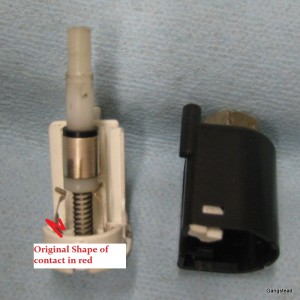Last week I did a fix on my Tacoma that saved me $60. My old trusty Taco has been getting a little less trusty lately. It’s starting to get a little long in the tooth (it’s a 1999 model, I’ve had since 2001).

Problem:
It’s a manual model and last week it stopped starting in the middle of a road trip. In a manual you have to have the clutch depressed all the way for the engine to turn over unless you press the “Clutch Start Cancel” button.

This button allows you to start the car without the clutch pressed back all the way. I’ve never found a real use for this button, who would want their car to lurch forward when they started it? I’ve read online some people do it when they want to warm up their car in the winter, but sitting in it long enough to start it wouldn’t bother me. Then again I live in Texas so in the winter it doesn’t take a car to warm up from 40 degrees.
I used the clutch start cancel button until the weekend when I could take a look at it. Since the truck was otherwise running fine I figured it had something to do with the switch that the clutch depresses when you push it back. Under the dash I went and the switch appeared fine, depressed smoothly. I went by the Toyota dealership and they said they could order me a new switch for $55 plus shipping and handling for a total of sixty something dollars. I need to change careers and just make little switches for Toyota. This thing is 1″x.5″x1″ you could fit $1000 worth of them in your pockets. It was worth a little more exploration before shelling out $60 for a switch.
I undid the nut and the connector and took the switch off:

Looked alright, but was getting weird readings with the multimeter when I measured from the switch’s contacts and moved the plunger in and out. Sometimes it would short, sometimes it wouldn’t. There were 3 plastic tabs on the white base of it that hold the black cover on, I teased those loose with a screwdriver and found the problem.

Solution
The switch was pretty simple. The metal part of the plunger, when pushed down, makes connection between the two contacts on either side. When I opened it up the left one was crushed down to the bottom. Instead of the plunger sliding between the two it had flattened one of them. I think I did this when I was stretching my foot (I was on a road trip). It would still occasionally make intermittent contact depending on how the crushed contact lined up. Since I didn’t take a picture until after I bent it back into a roughly straight line here’s a handy Paint diagram:

Put the switch back on and the truck starts up great now. I can’t be too mad at Toyota, I did nudge the switch, but it had enough wiggle room in it for it to come down on top of the contact. I’m also not that mad when a switch only lasts 12 years. Still I should get into the $60 switch manufacturing business.
Time:
1 hour total, I mostly in tinkering
Money:
$60 (saved).
Awwwwe, such a genius you are! Dad would be so proud!
It must have taken you longer to write this awesome, high quality blog post than it did to fix the problem. I hope there are 1000’s of truck owners out there with broken switches to read this.
If not, then I just thought of a sabotage-related adjunct activity that you could pair up with the switch making business…